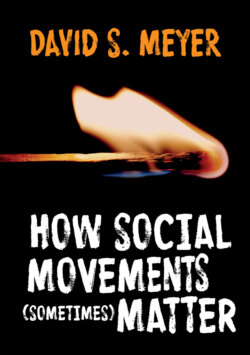Читать книгу How Social Movements (Sometimes) Matter - David S. Meyer - Страница 10
Social Movements, Events, and Political Context
ОглавлениеThe world outside a movement is critical to how much that movement can grow, and we can think about that world as offering a set of political opportunities (McAdam 1982; Meyer 2004; Tarrow 2011; Tilly 1978). Potential participants in a social movement look at the world around them when they decide how to respond to an invitation to act. They need to believe that a cause is actionable, and that it’s possible – or safe enough – to join with others (Gamson and Meyer 1996). No matter how good an organizer is, what’s going on in the rest of the world makes it easier or harder to sell his or her message.
Back to the American Revolution: Separated from colonial rule by the Atlantic Ocean, colonists enjoyed the space to do more than a little self-governance. Over time, they built wealth, organizations, and identities that were not exactly “British.” When England began to impose greater restrictions on the colonists’ business and autonomy, it created shared grievances in America, and those grievances contributed to the development of a distinct American identity. Colonists aggrieved by new taxes or restrictions on participation in governance initially tried to resist them; essentially, the first efforts were conservative ones, trying to keep things as they were. When this proved increasingly difficult, support for independence grew as the most viable alternative.
Political opportunities also include the means available to try to advance one’s political interests, and vary for different racial, professional, and class groups, over time, and across different contexts (Bracey 2015). Most people are unlikely to protest if they think they can get what they want by employing more modest means that entail less cost and less risk. Advocates experiment with different ways of getting what they want: writing letters, making speeches, organizing demonstrations, staging theatrical acts of vandalism, and ultimately, in this case, taking up arms and going to war. In the case of the American independence cause, there’s an interaction between social movements and the authorities they challenge – as is always the case in protest movements. When Britain punished the colonists and excluded them from normal institutional politics, it could have crushed the cause altogether; instead, it drove them to war as the best available alternative.
Some of the most educated and affluent people in the colonies were already familiar with philosophical arguments against monarchy, and the beginnings of a liberal philosophy of limited government (Wills 1978), but then, as now, relatively few people find the time to work their way through books of philosophy. As the cause of independence grew, however, Patriots developed ways to translate and promote their ideas to a broader public. A free press circulated work from advocates of independence. Most notably, Thomas Paine, newly arrived in America in 1774, promoted ideas of independence and human rights as “Common Sense” in 1776. The coincidence of the right text with a critical time produced a national bestseller, and gave the Patriots a script to justify their organizing efforts.
Ultimately, the colonists won a war of independence, but the ideas and the organizations inspired citizens of the new nation to demand more. Even as the revolution moved the locus of governance from London to colony capitals, the United States allowed slavery, the continued expansion to Indian territories, and some states did little of consequence to advance the interests of most of their citizens. Farmers in western Massachusetts, seized with the revolutionary spirit, in 1786 armed themselves and occupied a courthouse to protest the difficulties they had in paying debt owed to creditors who mostly controlled the legislature. Shays’ Rebellion helped provoke the Constitutional convention, which strengthened the federal government and made it even more difficult for farmers to get credit on the terms they wanted (Richards 2002). The Constitution also left some supporters of the revolution disappointed or angry. Farmers on the western edge of the early United States, accustomed to distilling their surplus grain for personal use and for sale, resisted a federal tax on domestically produced spirits. Beginning in 1791, recalling the principle of fighting “taxation without representation,” the Whiskey Rebellion included tax evasion, mass meetings and demonstrations, and physical assaults on tax collectors (Slaughter 1986). President Washington led a militia of 13,000 men to put down the rebellion, buttressing the new republic at the expense of the vision of many of those who fought for it.
Telescoping out from the Boston Tea Party, we encounter the complications in making an assessment of the influence of social movements. Even a simple reading of the event must situate it in a larger independence movement that, over a period of years, produced a war and a new nation. Even then, evaluating that movement as a success means neglecting the lofty aspirations and concrete expectations of many of those who turned out for the effort. For these reasons, the Tea Party provides a good way to start examining how social movements matter. The Tea Party and the larger American Revolution of which it was a part was a distinct series of events, whose outcomes were defined by context and contingency. Nonetheless, we can use it to establish and define concepts that will be helpful in understanding a wide range of other campaigns in a broad variety of contexts.
